
 (4 / 5)
(4 / 5)
There are many movies like Atomic Blonde. A sensitive, political situation where a top agent is called in to handle it and what follows is a chase, gunfights, hand-to-hand combat and some sharply worded moments over a bar. Many movies follow the same form, what matters is the effort and result. This decided new film from director David Leitch decided to use a more vibrant colour pallet and attempts to really make you feel the fights going on.
What is the plot? Who cares. Seriously though the movies premise is as simple as I previously described but in order to be professional I’ll elaborate. In 1989 the Berlin wall came down, the city was complicated in terms of it’s politics (to put it simply), spy’s are everywhere, one spy is taken down who has a list of the names of all the active spy’s, there is another man that wants to defect and has committed all the names to memory. So Lorraine Broughton is called in cause she’s the best at all secret agent skills. Honestly this doesn’t matter, the plot is a thin clothing line to take us from one set-piece and character after another.
Charlize Theron has established herself as one of our greatest living actors. Able to handle intense emotional material and be the grand star of a blockbuster. This is a role where she is the Fe-male equivalent of James Bond, stylish, a drinker and very dangerous. She is beautifully shot however the filmmakers don’t just make her a something beautiful, she is a fighter and they give her bruises and cuts.
In Berlin her contact is David Percival (James McAvoy), a British agent that has allowed the corruption and brutality of Berlin to envelop him. McAvoy can handle this kind of role with ease, he is the kind of actor that believes in giving it all or go home. He gives it all.
During the day Berlin is a city of black and white, but at night it comes alive with dark shadows and turquoises and fuchia. The colors are in-keeping with the time and feel of the movie, disco and dance.
The extra layer of style in the movie is the soundtrack. Banging dance tracks that add a spicy tone to the movie as well as make the feel rather tongue-in-cheek. This works, it allows you to get into the rhythmic nature of the movie and know that it’s about the style and experience.
https://youtu.be/8JeU0_1CTdA
Not every movie needs to stir your soul. Others don’t even have to be that original in terms of their premise, but they do need to properly convey their goal. Atomic Blonde seeks to entertain you showing a dank, sexy ride. It does this very well, you are seduced by the aesthetic and engaged by the visceral action.
Category Archives: Film & TV
Review Dunkirk by Jonathan Evans
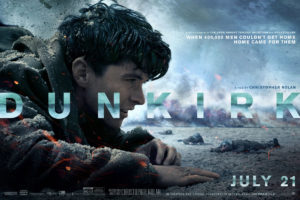
 (5 / 5)
(5 / 5)
There is the location, the situation, the characters and the deadline. All are set, wound up and then the ticking begins.
Dunkirk is not so much of a war movie as we traditionally expect one to be. We see soldiers, it is set in World War Two and there are moments of gunfire but its closer to Grave of The Fireflies because of it’s tone and more about the effect of war.
Our backdrop is the beach of Dunkirk where French and British soldiers were pushed back to and the Nazi’s have surrounded them and are going to move in for the kill. Some ships are coming to pick them up but they often get shot down by planes.
We have about three situations going on. One follows a young private named Tommy (Fionn Whitehead) who just wants to get on a ship and get out alive. Another follows Mr Dawson a man who owns his own boat and is taking it upon himself to rescue all the soldiers he can. Another is Farrier (Tom Hardy) a British pilot that has to defend what ships he can but a shot has rendered his fuel gauge broken so he has no idea how long he has left.
Seeing the movie is like seeing Hitchcock’s Notorious. Christopher Nolan has reduced this movie to as few spoken lines as he could and focused on sharply telling the story through visuals.
Throughout the movie it is all about choice. The characters are all facing death and how they decide to go about it. The young private doing all he can to stay alive, the pilot that is remaining in the fight to defend the troops as much as he can, even though his plane could give out any minute, the old man that has a boat so is going to pick up some soldiers even though he will most likely get shot down and die for nothing.
Over the course of watching the movie you will grasp that it is told out of order. Each characters narratives starts and you then learn that they intersect with the others. I tell you this because it isn’t really important, there is no twist involved with it, just a refreshing way to tell a plot with multiple characters from different perspectives. The kind of thing I expect and appreciate from Nolan.
This is Christopher Nolan striping himself back. His movies have become increasingly more dense and complicated, not in a bad way, though he has gotten pretty close to over-packing his movies. This is a simple concept with minimal dialog and more about clearly telling a gripping experience.
Review Shin Godzilla by Jonathan Evans

 (3 / 5)
(3 / 5)
Godzilla was first conceived as personification of the destruction caused by the nuclear attack on Japan with an anti war message behind the whole thing. Though through other more child friendly interpretations and marketing gimmicks the king of the monsters has been made into a joke. Though there are limitations on how seriously the image of a man in a rubber suit as well as the concept of a giant lizard destroying a city can be taken there is no doubts that the first movie meant it to tackle serious subject matters.
In 2014 we got the Hollywood version of Godzilla by Gareth Edwards, which is one of the most unhappy times I have ever had in a movie theatre. We hardly ever got to see Godzilla, the human characters were un-engaging and the image was so dark that hardly anything could be seen.
Now for whatever reason Toho has decided to make their own movie. Reintroducing the character for a new audience. It opens on a day like any other, only this day there are movements coming from the sea, first just ripples, then things start poking out, eventually it moves into the city and nothing stops it. So now the people in-charge must make decisions on how to deal with this creature.
Though we still live in a world where the threat of nuclear annihilation is possible, it’s not the prime concern. This movie’s focus is in dealing with a colossal threat that seemingly comes out of nowhere. It layers itself with seeing Godzilla on the move and the devastation he is raining down and the officials running around trying to understand the creature and make decisions.
In the directing chair is Hideaki Anno, legendary anime director who will probably always be closely associated with Neon Genesis Evangelion (which also includes the earth dealing with giant monsters attacking them) one of the most legendary titles in anime. This is his first work in live action and he adapts well. He knows how to visually convey information with a few or even a single image.
This design of Godzilla is probably the most threatening and horrifying version that’s ever been conceived. They stay true to the mentality of a man in a rubber suit, having his movements be slow and limited. His skin looks like glowing, burning scabs, tiny and focused eyes like that of a shark a mouth filled with razor sharp teeth.
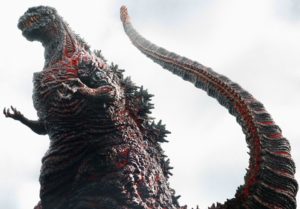
Along with the new look is also the classic powers that he’s known for and some new ones that are explained by adding something to the mythology. I wont tell you what it is but its a satisfying one that allows the legend to adapt and grow in this new time.
Though the sharpness of special effects is not everything, not even the most important thing in movies it is still important. This is because if we don’t believe that monster, spacecraft, laser-blasts, castle are really there then we are taken out of the experience. The rendering of Godzilla is shoddy to be frank, especially in the early stages, other things like trains look rather fake too, however such things are forgiven if they are in a story and situation that has grabbed you.
There are many human characters in the movie that all run around the rooms and spout their opinions and facts that are coming in. There are definitely over twenty characters that are introduced through a gauntlet of a passe. They talk very fast and their credentials pop on-screen at the same time, never stopping. There is a part in the movie where they all wake-up from working all night and decide to take a break and eat, then they reflect on how hard everyone has been working. This moment alone lets you connect and feel for these characters more than any complicated speech or feat of heroism. However I’d still be lying if I said you walked away really having gotten to know anyone.
This is not the great reinvention of the character or the monster. But I have seen how bad a movie like this can get. It is not boring and the image is clear and the sense of panic and destruction are effective.
Review Valerian by Jonathan Evans
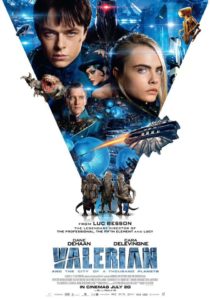
This movie is like having a lot of sugar. It’s stimulating, fun, you enjoy it while it’s happening and by then end you feel tired.
We get two openings. Our first shows us that humans have made it into space and as generations pass more nations of the planet Earth join together above the planet. More and more joint and eventually Extra Terrestrial life. The mass of ships becomes too big and must move off further into space where it has become a manufactured planet. Following that is a scene where we are shown thin, pale aliens on a shining beach planet. They seem to have some kind of ability to transfer energy into pearls. Suddenly a great explosion strikes the planet and most of the species is wiped out. One of them closes their eyes and extends their arms and when they die a blue aura is sent out.
Both these segments are told with absolutely minimal amount of dialog. This is a good thing, it is a sign of talent when you can tell the story without words because it means that there is an understanding of visual language.
Said blue aura travels across space and wakes Valerian (Dane DeHaan) relaxing on a tropical beach, he’s joined by his partner Lauraline (Cara Delevingne). What follows is some light flirting and exposition about their relationship. They are partners that are hired to do jobs for the government and have possibly been together before but are not official, Valerian wants to marry her but she doubs his commitment (given his history).
Dane DeHaan, though has proven himself as a talented actor, is either miscast as a swashbuckling space hero that this character is meant to be or Besson didn’t do much to guide his character development. Cara Delavine plays her role better though there is a certain lack of conviction. It feels like she really needs to land a good role in a solid movie, this and Suicide Squad haven’t done her any favors.
This movie has so many visuals, it is very rich in ideas of alien designs, colors it wants to incorporate and architecture of ships and buildings. That is in no way a bad thing but sometimes it wants to use all of those elements in the same shot, sometimes while it’s flying through the scenery, which results in a cluttered image where you can barely make anything out.
The movie is certainly not guilty of incorporating many different colors into it’s images. We exists in a time where many movies use black in overabundance or take on a monochrome look, this infuses its characters in blue light with some amber for contrast. It’s fun imagery that often leaves any practicality behind, why are there clouds that are green and also red? It looks cool that’s why.
The movie also comes with a few really neat ideas for situations. There is one where people attend a market that exists in another dimension, one sequence where Valerian has to run through the walls of a city which rapidly changes the color pallet and visuals. These sometimes do feel like a video game that you’re just not allowed to play. Though even with that this movie is still trying to show and impress.
During the rest of the movie and especially at the end it tears apart all the confidence and good work in the opening sequences because there is a big exposition dump on the audience that explains things that only needed a little explanation or none at all. It is easily the worst part of the movie, dragging terribly.
Luc Besson definitely wanted to impress with this movie. He wanted to construct a movie using all the colors he could and craft an epic science fiction tale with dense politics with a love story at the center of it all. Nothing in the movie is bad and there are a few moments that are more than memorable and genuinely well crafted. Though there’s not much else for repeated viewings. Go once and don’t expect to be moved, but see an extravagant science fiction that doesn’t look like any other.
Rating: 3 stars out of 5
Review National Theatre Live: Angels in America Part 2: Perestroika by Danielle O’Shea
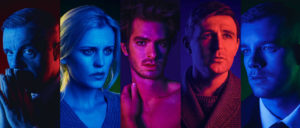
 (5 / 5)
(5 / 5)
You can read Danielle’ s review of part one at the link below
getthechance.wales/2017/07/22/review-national-theatre-live-angels-america-danielle-oshea/
Extending on the theme of survival, the second part of Angels in America questions progress as a way for religion, society and humanity to survive. Moving further from the domesticity seen in Part 1, hallucinations and prophetic visions become all the more common and fantasies, whether they be of Heaven or Antarctica. But despite this change in tone, emotions still run high due to discussions of more minor themes still relevant today such as healthcare and the justice system.

Overall, Perestroika is a deeper exploration of the themes of Millennium Approaches and it reveals that what is beneath the message of survival is one of hope even in the bleakest of times.
In its entirety, Angels in America is a magical, modern questioning of identity and change that takes the entire audience on a journey through dark and light times before leaving them with a message of overwhelming hope.
27th July 2017
Gwyn Hall, Neath
Running time: 4 hours 20 minutes with two 15-minute intervals
Author: Tony Kushner
Director: Marianne Elliott
Design: Ian MacNeil (Set Designer), Nicky Gillibrand (Costume Designer), Paule Constable(Lighting Designer), Robby Graham (Choreographer and Movement), Adrian Sutton (Music), Ian Dickinson (Sound Designer), Finn Caldwell (Puppetry Director and Movement), Finn Caldwell and Nick Barnes (Puppet Designers), Chris Fisher (Illusions), Gwen Hales (Aerial Director), Harry Mackrill (Associate Director), Miranda Cromwell (Staff Director)
Cast: Susan Brown, Andrew Garfield, Denise Gough, Nathan Lane, Amanda Lawrence, James McArdle, Nathan Stewart-Jarrett, Russell Tovey, Stuart Angell, Laura Caldow, Claire Lambert, Becky Namgauds, Stan West, Lewis Wilkins
Review War for The Planet of The Apes by Jonathan Evans

 (4 / 5)
(4 / 5)
Back in 2011, if you would have told me, or anyone that a prequel series to The Planet of the Apes would be one of most consistent movie trilogies with one of the most engaging movie characters in a while, hardly anyone would have believed you.
Yet here we are, the third movie where we see how we get the to the status of Apes being the rulers of the planet. Along the way we’ve had the development of of very engaging character, seen the mastery of a special effects art-form and been dealt engaging scenarios. I certainly wouldn’t have guessed this.
Our status is that Caesar and his group of apes are on the move and looking for a new place to call home. They need to move because of the war which was ignited in the last movie. They seem to have found an ideal place but the night before they move-out a human platoon invades and kills Caesars wife and eldest son. The one who killed them and the leader of the humans is a man simply referred to as The Colonel (Woody Harelson). Now Caesar sends his apes off to their home but he cannot go with them, he must have his revenge.
The digital effects in producing these apes continues to impress beyond measure. We are able to see (roughly a hundred) apes onscreen at the same time, of all different species (gorilla, orangutan, chimp etc.) and each of them has something distinctive about them (a scar, different colour eyes etc.) so we can recognise them. As well as that they take the texturing of the fur and present all kinds of different variables. Dry and windy, raining and damp and others with flakes of snow resting on them. All of these are rendered in razor sharp detail that pushes the line of what we can distinguish between an effect and live action.
But beyond the surface level of these apes it’s the motion-capture technology and the actors within it that are truly bringing these characters to life. The most notable is of course Andy Serkis as Caesar who has mastered the art of motion capture, he is able to figure out the mentality of a character, even a species and match them with their walk and movement. But he goes a step deeper than that, he gets deep into the characters mentality and allows it to shine through little moments of shrugs or facial movements.
Even though this movie is about conflict and has “War” in the title there are many scenes that are quiet and some even that go by without any spoken words of dialog. This movie understands that in order for the action to matter you must first have moments of calm and build a connection with the characters that doesn’t come through them screaming and shooting a gun constantly.
Throughout the story there’s quite a few heavy servings of Christ symbolism. Not something I’m a fan of. The symbolism can work, however only sparingly and with a light touch. This doesn’t and because of that it comes off heavy handed. We see it, know exactly what they are doing and are taken out of the moment.
All three of these movies have never forgotten one thing, that there is good an evil on both sides. There are the greedy, the righteous and the hateful and they all populate either side. These movies understand humanity better than most movies that have come out to portray any conflict.
These movies have shown the birth and establishment of a new species that have had to struggle to survive and other moments where peace might have been a possibility but others couldn’t let it happen and how that war comes with server cost to all. These movie are surprisingly some of the most engaging cinema to come out in the last decade.
Review National Theatre Live: Angels in America by Danielle O’Shea
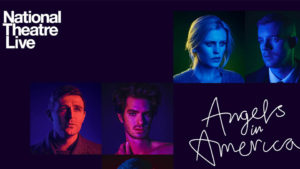
 (5 / 5)
(5 / 5)
Survival is central to the first part of Tony Kushner’s “Angels in America”. This can be seen in the consideration of the fight to survive illness and addiction but also by asking how far you would go to make a relationship survive or to survive oppression. As well as survival, themes of morality, religion and politics remain essential to the play and are used as tools for character development.
As mentioned in the pre-show interview with its director, Marianne Elliott, the play moves from domesticity to magical realism due to the hallucinations experienced by several of the characters which become more overwhelming as the play progresses.
Rooted in 1985 New York during the AIDS epidemic, the harsh reality of each character’s situation is evident and is kept in mind through the use of three side-by-side mini sets so even as the play moves from one character to another, their set remains darkened but still visible. The neon lights bordering each set give an almost magical aura but initially act as barriers between characters before falling away and allowing characters to cross them.
The entire cast give incredible performances that portray characters vividly and in a way so that no matter their moral or political stance the audience still builds a connection with them. However two actors in particular captivate the audience, Denise Gough as Harper Pitt, a Valium addicted Mormon housewife, and Andrew Garfield as Prior Walter, a charismatic AIDS sufferer. Both characters act as bridges between fantasy and reality and their one scene together was charming and captured the attention and imagination of the entire audience.
As a whole, Angels in America is a stunning political portrait that remains extremely relevant today due to its discussions of American politics and the changing identity of America. It is an emotional roller-coaster that will keep you on the edge of your seat and I will definitely be seeing the second part.
National Theatre Live: Angels in America
Part 1:Millennium Approaches
20th July 2017
Gwyn Hall, Neath
Running time: 3 hours 40 minutes with two 15-minute intervals
Author: Tony Kushner
Director: Marianne Elliott
Design: Ian MacNeil (Set Designer), Nicky Gillibrand (Costume Designer), Paule Constable(Lighting Designer), Robby Graham (Choreographer and Movement), Adrian Sutton (Music), Ian Dickinson (Sound Designer), Finn Caldwell (Puppetry Director and Movement), Finn Caldwell and Nick Barnes (Puppet Designers), Chris Fisher (Illusions), Gwen Hales (Aerial Director), Harry Mackrill (Associate Director), Miranda Cromwell (Staff Director)
Cast: Susan Brown, Andrew Garfield, Denise Gough, Nathan Lane, Amanda Lawrence, James McArdle, Nathan Stewart-Jarrett, Russell Tovey, Stuart Angell, Laura Caldow, Claire Lambert, Becky Namgauds, Stan West, Lewis Wilkins
Series Review, Broken, BBC by Gareth Williams
 (5 / 5)
(5 / 5)
Father Michael Kerrigan is the latest name to add to the growing pantheon of priests appearing on our television screens in recent years. Following in the footsteps of Tom Hollander (Rev), James Norton (Grantchester) and Mark Williams (Father Brown) is another acting heavyweight, Sean Bean. Bean takes the lead role in writer Jimmy McGovern’s latest drama, Broken. The six-part BBC series has seen Kerrigan battling his own personal demons whilst acting as counsellor, social worker and friend to his parishioners. The narrative has been suitably gritty, tackling poverty and injustice unashamedly through the lens of social realism. It is, of course, what McGovern does best. It could even be argued that Broken is among his best work.
Sean Bean is a fascinating lead actor. He is utterly mesmerising here. The emotion etched on his face conveys perfectly the inner turmoil and wretched guilt of his character. There is no need for words. He makes Kerrigan so likable, so genuine. It is hard not to fall in love with his character. His flaws and his mistakes and his heartfelt pleas only increase our empathy for the man. Kerrigan is broken. Yet in his brokenness we see something of our humanity – for better and for worse.
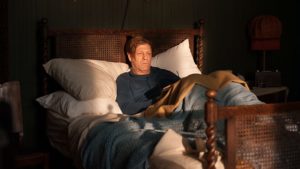
The opening credits seem to capture this sense of conflict perfectly. It is so beautifully melancholic: the heart-rending tones of Nina Simone singing “Human kindness is overflowing/ And I think it’s going to rain today”. It is this overwhelmingly positive image streaked with an impending sense of despair that wonderfully encapsulates the stories at the heart of this drama. In particular, the investigation into the death of Vernon Oyenusi (Jerome Holder) places a focus on PC Andrew Powell (Mark Stanley) as he wrestles with the personal and professional consequences of telling the truth. He wants to do the right thing, but there is a cost for doing so.
McGovern finds rich material here. He touches on some of the hypocrisies of the institutional church. He tackles issues of homosexual acceptance and the morality of gambling. There is also the moment when Kerrigan faces up to one of his former teachers who, as we see in flashbacks, abused him. The lack of remorse shown by Father Matthew (Robert Gillespie) is infuriating to say the least. Yet Kerrigan’s response is measured. He doesn’t lash out in justifiable rage yet the emotional anger underneath is evident in this incredible exchange. Again, Bean’s acting is masterful.
The standout episode of this fascinating series has to be the fourth offering. It finds single mother Roz (Paula Malcomson) facing up to the reality of her fraudulent past. She owes over £200,000 to her employer and confesses to Father Michael that her only way out is to take her own life. It is complete dramatic perfection from McGovern: raw, heart-breaking, full of understated emotion and grounded in the ordinary reality of daily life. It is also where Broken becomes an ensemble piece rather than simply a protagonist-led drama.
Jimmy McGovern is a master at creating fully-formed and multi-layered characters. The leading light in this drama is certainly Kerrigan. However, as the series progresses, he becomes like the candle he lights to declare the presence of Christ. This simple yet powerful motif reflects Kerrigan’s role in the community: he is present amongst his parishioners but he is no superman solving all their problems. He is there for them, but he is helpless as much as he is helpful. He is part of their lives, but they have their own stories to tell – he does not define their decisions or determine their choices necessarily.
The place that McGovern gives to Father Michael Kerrigan is far less certain than the clear morality of Sidney Chambers’ crime-solving world in Grantchester. Yet it is somewhat more assured than the struggle for relevance that faces Adam Smallbone in Rev. This is what makes Broken such a fascinating series, particularly in the canon of TV shows with a clerical protagonist. For McGovern, the church remains a place where hope is found. But this hope is expressed through the individual (Kerrigan) rather than the institution (as represented by Adrian Dunbar’s Father Peter Flaherty). In this way, the final scene makes perfect sense. Being critical, it could be seen as a little too perfect, almost sentimental. Nevertheless, it still elicited a few tears from me in response.
Broken is an excellent and inspiring drama. It continues Jimmy McGovern’s reign as one of Britain’s best and most provocative of writers. The acting talents of Sean Bean, et al. only add to the sheer quality on display here. It is surely one of 2017’s best dramas.
Review Spider-Man: Homecoming by Jonathan Evans
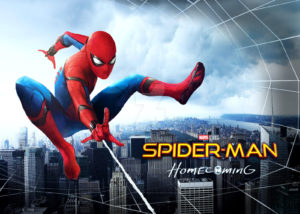
 (4 / 5)
(4 / 5)
For the past decade (roughly) Spider-Man has been the legal property of Sony, within the movies. MARVEL nearly went bankrupt back then so sold the character to make some money. Since then MARVEL movies have become the biggest and consistently high-quality movie series in history. However they’ve had an arm tied behind they’re backs with not having the rights to all their characters. Now an agreement has been reached that Sony will allow Spider-Man to be used in their cinematic universe.
This movie opens after the devastation caused at the end of Avengers and a clean-up crew is clearing debris and packing up alien technology. They are then halted in doing so by higher officials saying that they are taking over. This means that a bunch of them are loosing their jobs. They have already taken some of the technology so instead of turning it over they keep it for themselves for their own ventures.
Cut then to a few years later when Spider-Man first appeared in Civil War, he’s vlogging the whole thing. So now after all the events Peter Parker a.k.a. Spider-Man must now wait until he’s needed for another mission with the Avengers. He waits, stops burglaries and other little crimes and waits for the call.
Tom Holland plays Peter and Spider-Man as someone who is in awe with most of the amazing things he gets to see and experience. When he sees another Superhero he falls to pieces and talks all about them. He’s simply an energetic, well meaning kid.
Being that getting this movie made already came with it’s share of legal baggage, two different companies have to have their say on the character, as well as a total of six people on the screenplay, the odds seemed good that this movie would have been a mess.
Soon we see that the men that took the alien technology has created their own heist operation, where they steal and sell weapons to local thugs. Their leader is a man Adrian Toomes, who is playing The Vulture, even though he is never referred to that by name. Michael Keaton brings him to life with a kind of subtle malice. He’s not a complete, raging psychopath, you can see though and control, but also that there is clearly danger lurking below the surface level. He has equipped himself with robotic wings that come with a few gadgets and blades so he provides more than a threat.
The other supporting cast comes in the form of Aunt May (Marisa Tomei) that proved a fresh no-nonsense support for Peter. Being that he recruited him in Civil War Tony Stark (Robert Downey Jr.) returns for this movie and plays the mentor/father figure, giving pieces of advice and plenty of criticism. His best friend Ned (Jacob Batalon) that provides extra elements of comedy and allows Peter to spell things out for him because he knows so little about the Superhero world. Then there’s Michelle (Zendaya) a wonderfully confusing contradiction that says she doesn’t care about any of the social events or trends but is still apart of all of them.
Donald Glover makes an appearance as Aaron Davies, a low level crook that actually cooperates with Spidey. Glover made some political waves when he put himself forward for Spider-Man a few years ago and asked the question why couldnt an African American man play the Wall-Crawler. He did voice the Miles Morales Spider-Man (alternative version) in an episode of Ultimate Spider-Man and here he still gets to be a part of the world he clearly loves.
In 2002 Sam Rami made his version and then 2012 it got rebooted with Andrew Garfield in The Amazing Spider-Man, which ended with it’s sequel in 2014. A criticism for this movie and even putting the character into Civil War was that the public is tired of starting this character over AGAIN. The concern is fair, how many times can we see the same story repeated exactly? Well a lot if human history is anything to go by. But what they do is make the decision to forego the origin and tell Peter’s story after-the-fact.
Spider-Man has always been about all the little things getting in the way. This movies plot is bogged with all kinds of commitments ans scheduling conflicts that wouldn’t be a big deal to Captain America or Thor but Peter is tethered to such menial links in his life. It has always been the most humbling and connectable element to the character.
This movie is refreshing from some of the other MARVEL movies because of it’s lower scale. Like with Ant-Man this follows what came before and acknowledges that this is a world where giant aliens can descend from the sky and cause mass destruction, but tells its story from a lower scale perspective. It’s a good way to refocus these movies and not make every movie about a city or continent being smashed to pieces.
This movie is fun. It has bright, vivid colors, a plot that is simple to understand, characters that poke fun at each-other and some story details and along for the ride are a few energetic, creative action sequences.
Review Baby Driver by Jonathan Evans
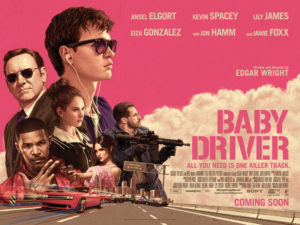
 (5 / 5)
(5 / 5)
In a movie there is the image, the score, the sound effects, the performances, the camera movement and, if so chosen, the colour. Usually one element shines or we can say that two were in great harmony, but almost never can they all be brought together, layered and baked to create one infusion of all creating a great experience.
Like what Damien Chazelle did with La La Land, Edgar Wright takes the elements, aesthetics and sensibilities of the old and create something modern with them. With that movie it was the Hollywood musicals, here it’s the pulpy heist movie.
The car pulls up outside a bank three of the people in the car get out, go to the trunk and take out guns then they slip on masks and enter. Another remains in the car, a young man that decides to lip sync along to the tune playing on his iPod. When they come back he drives. The young man behind the wheel goes by Baby.
Baby is a fresh faced young man that’s constantly plugged into his iPod listening to music with a pair of sunglasses on. He listens to music because he suffered an accident at a young age so he plays music to drown it out. Ansel Elgort plays him with swaying interest. At times wanders through life being much more interested with the music playing in his ears and others completely focused on his situation.
Baby’s employer and the one who setups these heists is Doc (Kevin Spacey) a controlling, nonsense man that goes by the mentality that it’s either his way or the highway. There’s also Buddy (John Hamm) and Darling (Eliza Gonzalez) a married couple that are like Bonnie & Clyde, happiest to be in each-others company while pulling these jobs. Then there’s Bats (Jamie Foxx) who seems more than a little unhinged, crime seems to come almost too easy to him. Naturally these are just code-names so none of the members can turn in the other as well as making the characters more easy to remember, like in Reservoir Dogs.
A an extra storytelling layer the ringing in his ear serves as so much more. We as mammals have learned to be fearful of high-frequency sounds because we used that to predict earthquakes. So that noise is cutting to a deep base instinct within us as human beings. We feel that either the situation is untrustworthy or that something bad is coming.
If you decide to make your movie in colour then you must use the colour. Most times filmmakers have a colour movie because that’s what expected of them and put no extra thought into the extra layer of storytelling they have. Not here. The movie has an appealing colour pallet of minty colours with a few deeper ones in harsher scenes. Every character has their colour which they either wear of expresses itself on the setting.
The editing, like all Wright movies, is a sleek, succinct experience with no frames gone to waste. He uses his regular tricks of panning’s combined with wipe cuts to create a seamless momentum that takes from inside, to outside, from one setting to another in within thirty seconds that would take others much longer. Other times he incorporates long shots that play like a skilful ballet between the actor and the camera. Within the moments of snappy cutting it never becomes confusing or disorientating because a) whats in the shot is simple and clear b) the colour helps to further register who it is doing what.
The soundtrack is composed with the greatest care. Edgar Wright is clearly a music enthusiast but it goes beyond that. We’ve had soundtrack’s with plenty of catchy songs in them (example Guardians of the Galaxy) but this goes deeper. This picks a song and completely dissects it in terms of it meaning, the lyrics, the rhythm and tone and infuses it into the scene. Sometimes it obviously fits the context of the scenes it picked for other times it ironically plays over a contrasting one.
One day, while getting coffee at his regular diner he becomes enchanted by the humming of a waitress Debora (Lily James). They both clearly have a love for songs and being on the road.
I have gone this far in the review without talking about what will probably be the main talking point for other critics, the car chases. They are well executed with fluid camera movements and impressive stunt driving as well as setups that are original, so much so that it’s almost like watching a martial arts fight scene with a car.
Baby Driver is a movie made by a man that loves nearly every aspect of cinema and is talented enough to draw as much as he can from every bit of footage he’s able to show you. Nothing goes to waste and is all entertaining. If you want to have fun you will be, if you wish to have an efficient, well crafted piece of cinema, you will also have that. Either way, take the ride.
